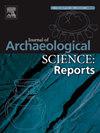The ‘Dame de Sabra’: New insights into the glaze technology of the Fatimids in Ifriqiya (10th century, Tunisia)
IF 1.5
2区 历史学
0 ARCHAEOLOGY
引用次数: 0
Abstract
The analysis of Fatimid polychrome white-opaque glazed ware found at the archaeological sites of Bir Ftouha and Utica (Ifriqiya) revealed that, contrary prevailing belief, the glazes were successfully opacified with quartz rather than tin oxide (cassiterite) particles. This led us to hypothesise that the use of cassiterite to opacify the glazes in Ifriqiya did not commence until well after the Fatimids took control of Egypt in 972. However, the absence of analysed ceramics with the most characteristic Fatimid designs among them left some doubts about the validity of this hypothesis. To elucidate this matter, an analysis was conducted on a ceramic vessel bearing the characteristic Dame de Sabra Fatimid design. This analysis has confirmed that the glaze was opacified quartz and not tin oxide particles. To date, no documented examples of pottery opacified with cassiterite have been identified in Ifriqiya in either the Fatimid or Zirid periods (10th to mid-11th centuries).
萨布拉贵妇人":对伊夫里基亚法蒂玛王朝(10 世纪,突尼斯)制釉技术的新认识
对在比尔富图哈和乌提卡(伊夫里基亚)考古遗址发现的法蒂玛王朝多色不透明白釉器的分析表明,与人们普遍认为的相反,这些釉器是用石英而不是氧化锡(锡石)颗粒成功地使其不透明的。这使我们推测,伊夫里基亚使用锡石对釉料进行不透明处理是在 972 年法蒂玛王朝控制埃及之后很久才开始的。然而,由于分析的陶瓷中没有法蒂玛王朝最具特色的图案,我们对这一假设的正确性产生了怀疑。为了澄清这个问题,我们对一件带有 Dame de Sabra 法蒂玛特色图案的陶瓷器进行了分析。分析结果证实,釉是不透明的石英,而不是氧化锡颗粒。迄今为止,在法蒂玛王朝或兹里德王朝时期(10 世纪至 11 世纪中叶),在伊夫里奇亚还没有发现锡石乳浊陶器的文献记载。
本文章由计算机程序翻译,如有差异,请以英文原文为准。
求助全文
约1分钟内获得全文
求助全文
来源期刊

Journal of Archaeological Science-Reports
ARCHAEOLOGY-
CiteScore
3.10
自引率
12.50%
发文量
405
期刊介绍:
Journal of Archaeological Science: Reports is aimed at archaeologists and scientists engaged with the application of scientific techniques and methodologies to all areas of archaeology. The journal focuses on the results of the application of scientific methods to archaeological problems and debates. It will provide a forum for reviews and scientific debate of issues in scientific archaeology and their impact in the wider subject. Journal of Archaeological Science: Reports will publish papers of excellent archaeological science, with regional or wider interest. This will include case studies, reviews and short papers where an established scientific technique sheds light on archaeological questions and debates.
 求助内容:
求助内容: 应助结果提醒方式:
应助结果提醒方式:


